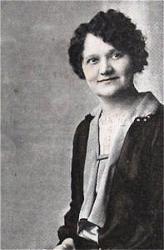Planning worship?
Check out our sister site, ZeteoSearch.org,
for 20+ additional resources related to your search.
- |
User Links
Person Results
Johann Balthasar König
1691 - 1758 Composer of "O DASS ICH TAUSEN ZUNGEN" in The Cyber Hymnal Johann Balthasar König; b. 1691, Waltershausen, near Gotha; d. 1758, Frankfort
Evangelical Lutheran Hymnal, 1908
Johann Balthasar König
Anna Hoppe

1889 - 1941 Person Name: Anna Hoppe Translator of "This Night A Wondrous Revelation" in American Lutheran Hymnal Anna Hoppe was born on May 7, 1889 in Milwaukee, Wisconsin. She left school after the eighth grade and worked as a stenographer. She began writing patriotic verses when she was very young and by the age of 25 she was writing spiritual poetry. After some of her poems appeared in the Northwestern Lutheran, a periodical of the Wisconsin Evangelical Lutheran Synod, they came to the attention of Dr. Adolf Hult of Augustana Seminary, Rock Island, Illinois. He influenced her to write her Songs for the Church Year (1928). Several hymnals include her work, which was usually set to traditional chorale melodies, although she also made a number of translations. She died on August 2, 1941 in Milwaukee, Wisconsin.
NN, from Cyber Hymnal
Anna Hoppe
Caspar Friedrich Nachtenhöfer
1624 - 1685 Person Name: C. F. Nachtenhoefer Author of "This Night A Wondrous Revelation" in American Lutheran Hymnal Nachtenhöfer (Nachtenhoefer), Caspar Friedrich, son of Caspar Nachtenhöfer, advocate at Halle, was born at Halle, March 5, 1624. He entered the University of Leipzig in 1647, as a student of theology (M.A. 1651). He was then for a few months tutor in the house of the Chancellor August Carpzov at Coburg. In the end of 1651 he was appointed diaconus, and in 1655 pastor, at Meeder near Coburg. He was then, in 1671, called to Coburg as pastor of the Holy Cross Church, and diaconus of the St. Moritz Church. He afterwards devoted himself wholly to St. Moritz, and died as second senior in charge Nov. 23, 1685 (Wetzel ii. 203; Allgemeine Deutsche Biographie xxiii. 192, &c) He published a metrical history of the Passion under the title of Erklärung des Leidens- und Sterbens-Geschichte Jesu Christi, at Coburg in 1685. Four hyms are ascribed to him, two of which have been tr. viz.:—
i. Diess ist die Nacht, da mir erschienen. Christmas. This is in J. H. Havecker's Kirchenecho, 1695, No. 406, in 5 st. of 6 1., marked as by M. C. F. N. It had previously appeared in the Coburg Gesang-Buch 1683 [Coburg Gymnasium Library], and is included in the Unverfälschter Liedersegen, 1851, No. 31. The translation in common use is:—
This is the night wherein appeared. A good and full tr. by A. T. Russell, as No. 58 in his Psalms & Hymns, 1851.
ii. So gehst du dann, mein Jesu, hin. Passiontide. This appears in the Neu -Vollständigers Marggräft. Brandenburgisches Gesang-Buch, Culmbach and Bayreuth, 1668, p. 81, in 4 st. of 8 1., entitled "A beautiful hymn for Lent." It is also in the Coburg Gesang-Buch, 1668, Appendix, p. 4, entitled "Christ's Death the sinner's Life." In both books it is without name of author. Wetzel ii. 206, ascribes it to Nachtenhöfer, and says it was written in 1651, while he was tutor at Coburg. It is a hymn on Christ's way to the Cross, and in the form of a dialogue between the soul and Christ. In order to complete the sense an additional stanza was inserted between the original iii. and iv., and this is the form in the Unverfälschter Liedersegen, 1851, No. 781. This new stanza, according to Wetzel ii. 210, is by Magnus Daniel Omeis, Professor at Altdorf (born at Nürnberg, Sept. 6, 1646; died at Altdorf Nov. 22, 1708), and was included in the Altdorf Gesang-Buch of 1699. The translation in common use is :—
So, Lord, Thou goest forth to die. A good translation of st. i., v. by A. T. Russell, as No. 92 in his Psalms & Hymns, 1851. [Rev. James Mearns, M.A.]
-- John Julian, Dictionary of Hymnology (1907)
Caspar Friedrich Nachtenhöfer


 My Starred Hymns
My Starred Hymns


